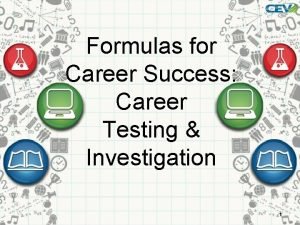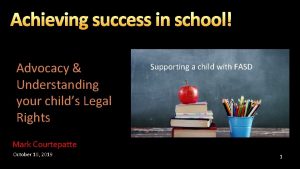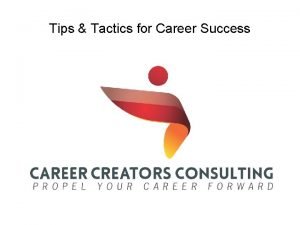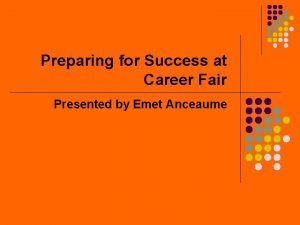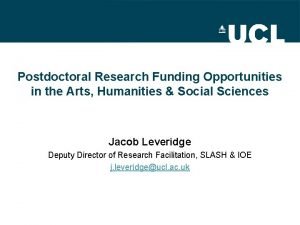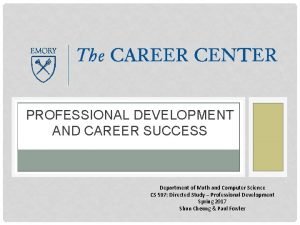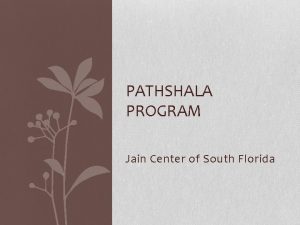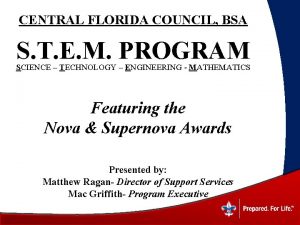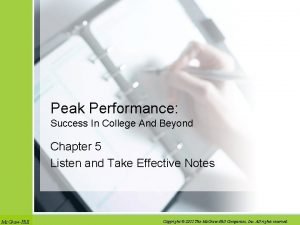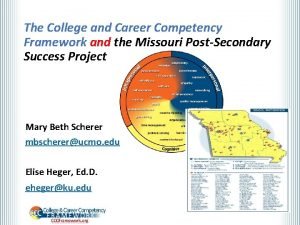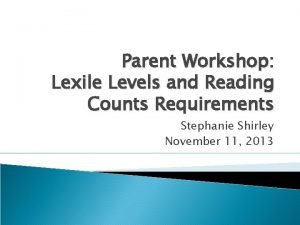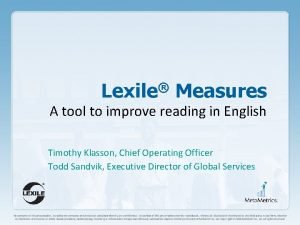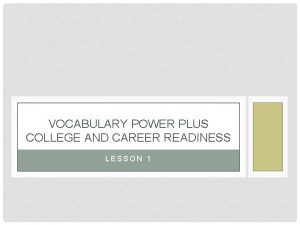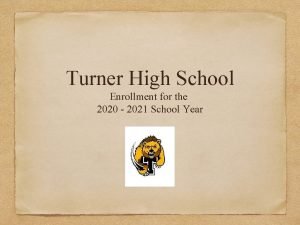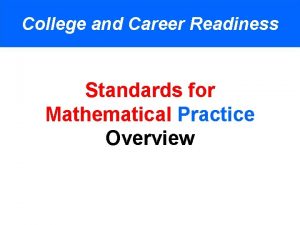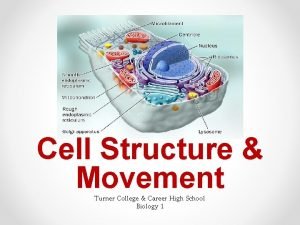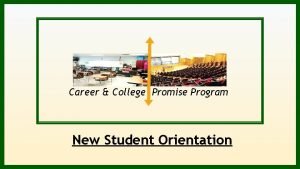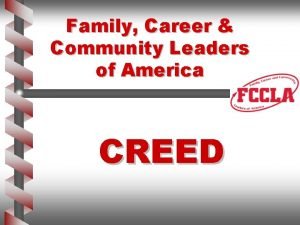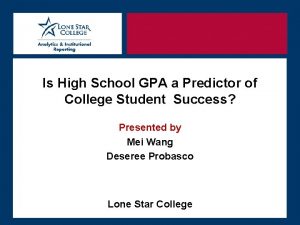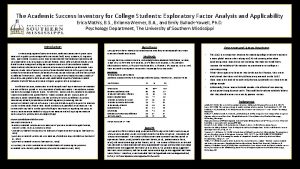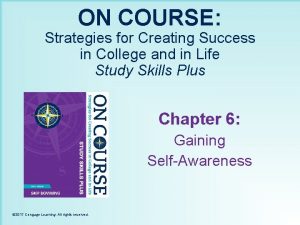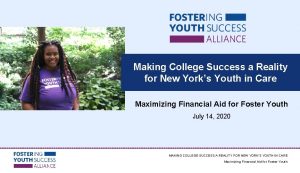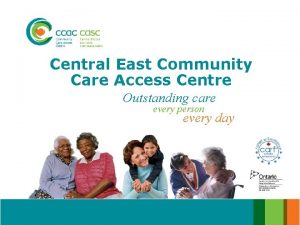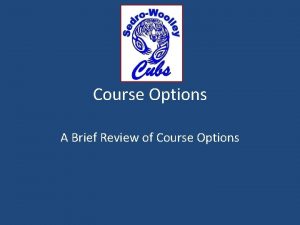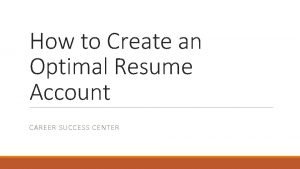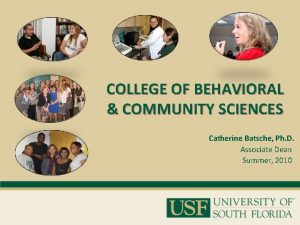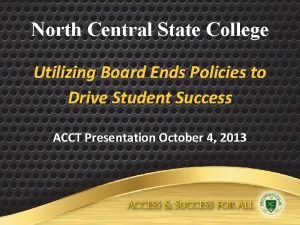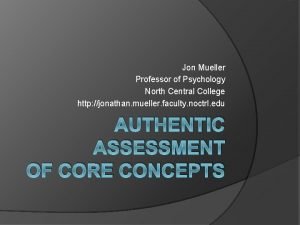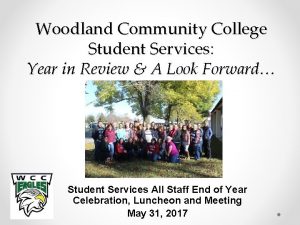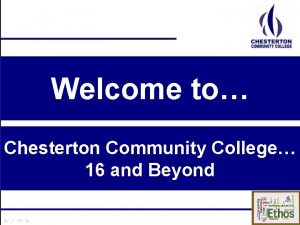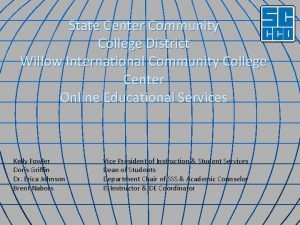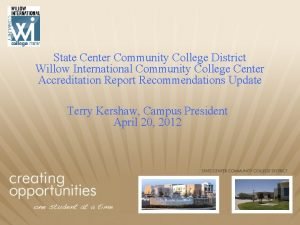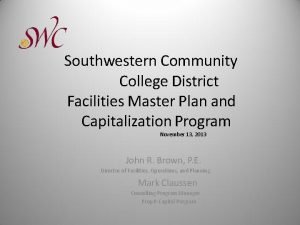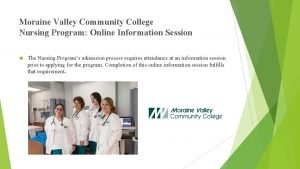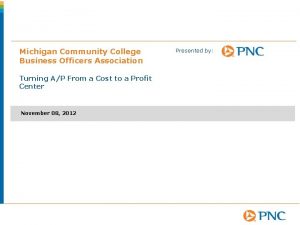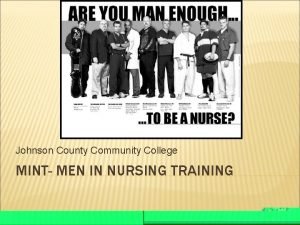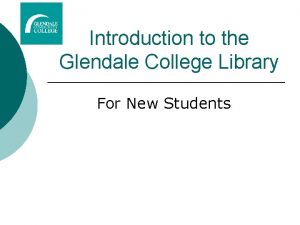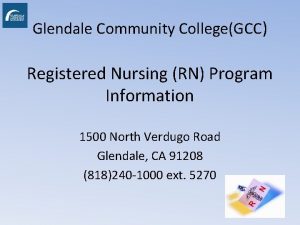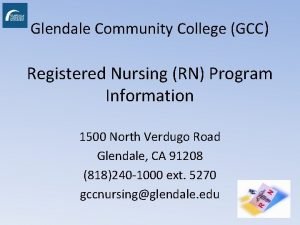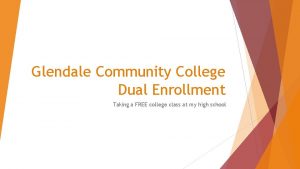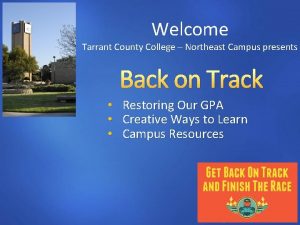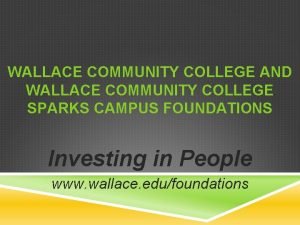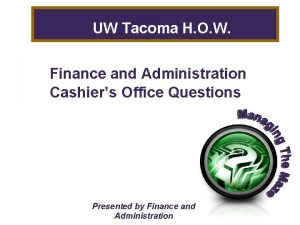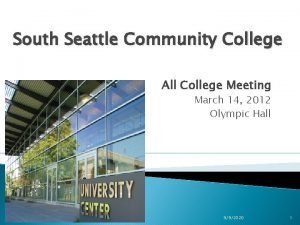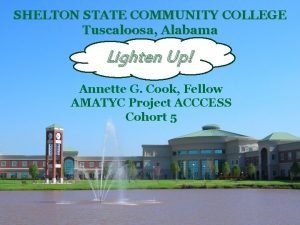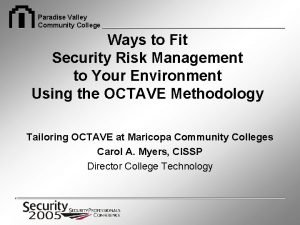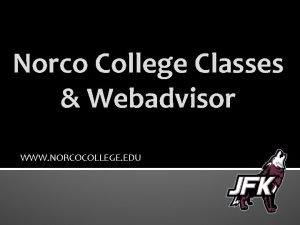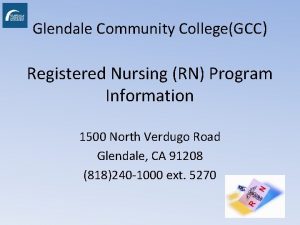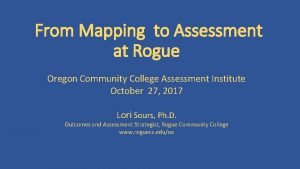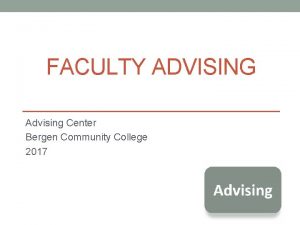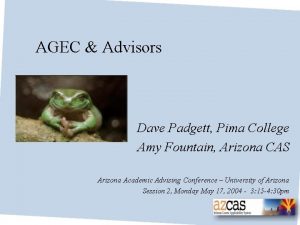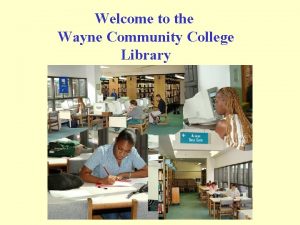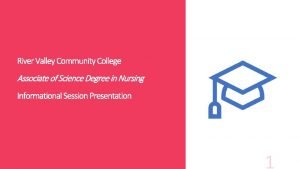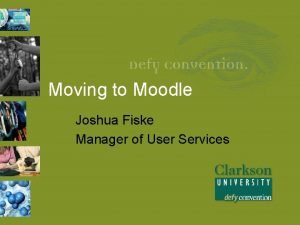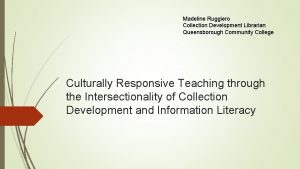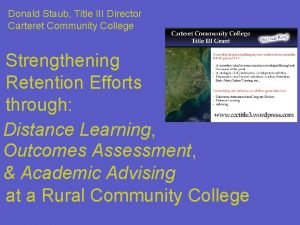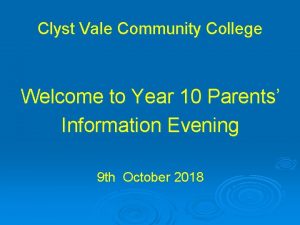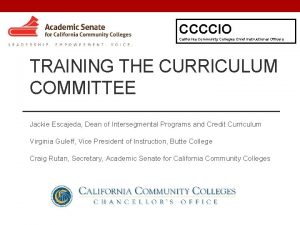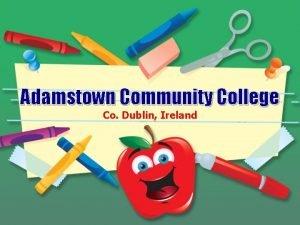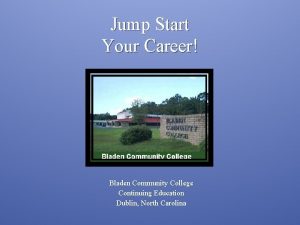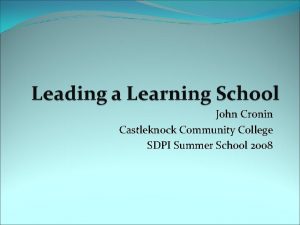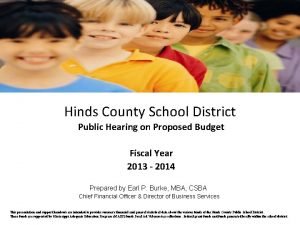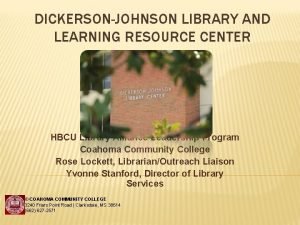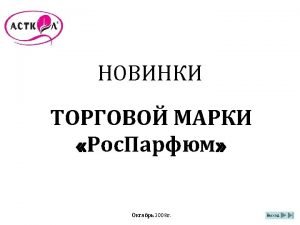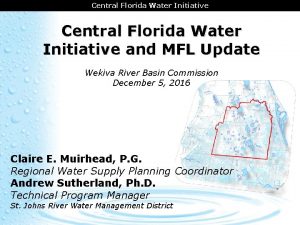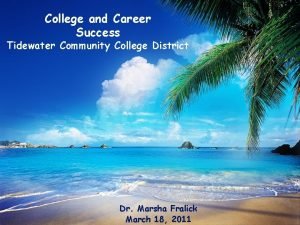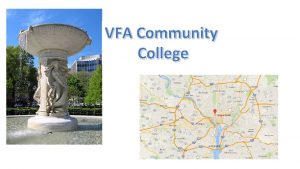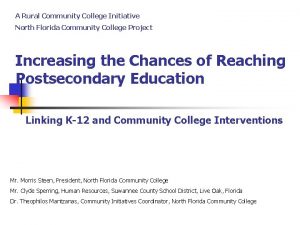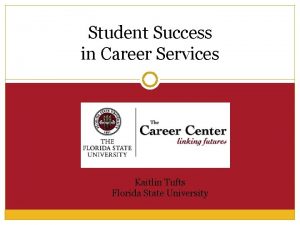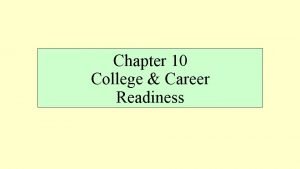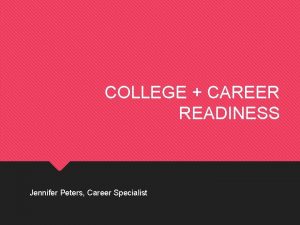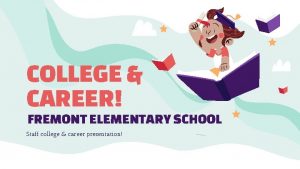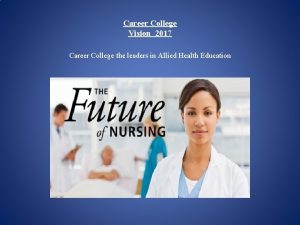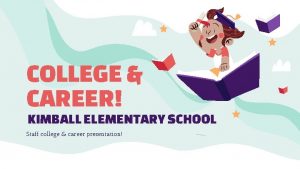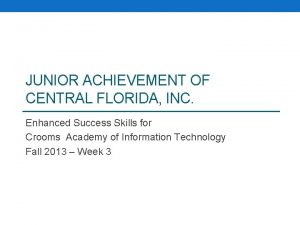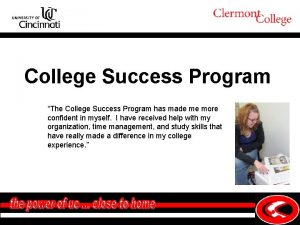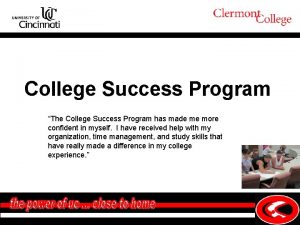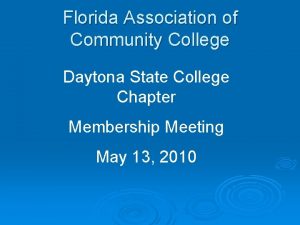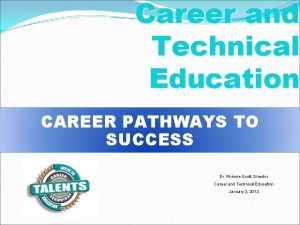College and Career Success Central Florida Community College





















































































- Slides: 85

College and Career Success Central Florida Community College Dr. Marsha Fralick

Ice Breaker • Introduce yourself. • What is your job title. • What do you do for fun?

Overview Morning • Features • Program overview • Student learning outcomes • Resources for faculty • Research on college success • Exploring personality type with Do What You Are • Exercises

Overview Afternoon • Exploring learning style with PEPS • Exercise • Using technology to engage students in learning • Tips for using the text • Engaging students in Learning • Practical exercises for the classroom • Favorite Exercises

What are your goals for this workshop? Think Pair Share


What’s New in the 4 th Edition? http: //www. collegesuccess 1. com/Whats. New. htm • Chapter Order • Personality and learning style moved earlier • Journal entries are online • Updated • New exercises

Features

Careers: A Key Component • Personality • Learning Style • Interests • Values • Career Research

Key Themes • Personality • Learning style

Carl Jung and personality type Online:


The PEPS Learning Style Assessment • Measures preferences in 20 areas

Keys to Success • At the end of each chapter • Inspiration • Positive thinking • For example: • Life is a dangerous opportunity

Broad Scope • College success • Career success • Lifelong success

College Success • Motivation • Time and Money • Memory and Reading • Test Taking • Taking Notes, Writing and Speaking

Career Success • Personality and Related Majors • Learning Style and Intelligence • Interests and Values • Career and Educational Planning

Lifelong Success • Communication and Relationships • Critical and Creative Thinking • Maintaining a Healthy Lifestyle • Appreciating Diversity • Positive Thinking • Life Stages

Applied Psychology • From theory to practice • Academically rigorous, yet practical • Easy to read

Engaging Students in Learning • Interactive activities within the text • Quiz yourself and answers • Journal entries • Individual and group exercises at the end of the chapter • Additional resources in the Instructor Manual

Student Learning Outcomes • What will the student be able to do as a result of taking this course? • The student will be able to. . • Suggested student learning outcomes

College Success 1 • Resources for faculty and students http: //www. collegesuccess 1. com/

Student Success • How do you know when your student success program is working? • Think • Pair • Share

Cuyamaca College El Cajon, CA

Personal Development 124, Lifelong Success • 8000 students enrolled in college • 2000 take PDC 124 each year • One of the top 15 revenue producing programs for the college • 56 sections a year

Make it Count • Transfers as general education for CSUC, Area E, Lifelong Understanding • Transfers to University of California

Course Choices • Face to Face • 22 sections • Blended • 22 sections • Online • 12 sections

Bridge High School Community College University


Program Results Program Review 2000, 2005

The most significant finding is increased persistence.

Persistence • Students who return the next semester • Approximately half of community college students nationwide do not persist after the first semester

College Persistence Semester to Semester 5 Year Average at Cuyamaca College • All successful PDC students 89% • All students 63% A 26% improvement!

Student Confidence • The course helped 62% of students feel more confident about their academic skills

Grade Improvement • 72% of student agreed or strongly agreed that the course helped to improve grades

Student Satisfaction 88% of students rated the course as very good or good.

College Success: A Study of Positive and Negative Attrition Community College Review

The Successful Student • Had a definite goal or college major • Earned a B+ or better in high school Based on this research, choosing a major and career planning was included in our college success course.

Choosing a Major • The course helped 52% of students choose a major

A Model Student Success Program • Broad in scope • Includes careers • Counts for graduation and transfer • Engages students in learning • Results in personal growth • Students become lifelong learners

Personality

How can a knowledge of personality type help a student to become successful? Think Pair Share

Understanding Type Helps Increase Student Success • Helps all students understand their gifts and talents and matching careers • Help at risk students to develop strategies to achieve their goals • Research has shown that ENFP, ESFP, INFP, ISFP have higher dropout rates

Student Success • Choosing a major • Career choice • Learning Style • Communication • Self-understanding

• Carl Jung and personality type Online:

Using the Access Code • Located on the inside of the front cover • There are clear directions on how to log in • It can only be used once

Carl Jung 1875 -1961 • We are born with natural preferences which we develop over a lifetime. • Exercise: What is a preference?


Administering the DWYA • Find a time when you are not tired or rushed. • There are no right or wrong answers. • Each type has their own unique gifts and talents.

Getting Good Results • Encourage students to give honest answers. • What are some reasons students would not give honest answers? • Think, Pair, Share

Administering the DWYA • The test does not measure: • Intelligence • Psychological or emotional health

Administering the DWYA • Answer the questions honestly to get the best results. • Answer the questions how you usually are when you are not stressed. • Do not answer the questions: • How you want to be • How you have to be at home, work or school • How others want you to be

Begin Self-Assessment How we interact with the world and where we place our energy E_______________|______________I Extraversion Introversion

Self-Assessment The kind of information we naturally notice and remember S_______________|______________N Sensing Intuition

Personality Exercise • Write about the picture for 5 minutes

By Ian Jackson

Self-Assessment How we make decisions T_______________|______________F Thinking Feeling

Self-Assessment Whether we prefer to live in a more structured or spontaneous way J_______________|_______________P Judging Perceiving

J and P Exercise: • Where do you stand? • I can play anytime • I have to finish my work before I play

Time for a Break?

The PEPS Learning Style Assessment • Measures preferences in 20 areas • Perceptual • Auditory • Visual • Kinesthetic • Tactile

Important Considerations • It is not a test • It describes how you prefer to learn new of difficult material • Usually there are 6 or 7 areas out of 20 that are important for an individual

Administering the PEPS • Give your initial response • No need to over analyze • Answer as though you were learning new or difficult information

PEPS • Immediate environment • Sound • Heat • Light • Design (formal or informal)

PEPS • Emotionality • Motivation • Responsibility • Persistence • Structure

PEPS • Sociological • Self oriented • Peer oriented • Adult oriented

PEPS • Physical • Time of day • Food intake • Mobility

Perceptual • Auditory (one third) • Visual (one third) • Tactile/Kinesthetic (one third) Learning disabled as well as gifted prefer tactile/kinesthetic


Learning Style Exercise: The Paper Airplane

Technology A Skill Needed for College Success and the Future World of Work


New Millennials • Our current college students • Most were born with a computer in the home and were using them by age 5 • Cyber generation • The connected generation • 82% are online daily • Average 12 hours per week online

Where are you in the technology continuum? • Baby boomer 1946 -1964 • Generation X 1965 -1977 • New Millennials 1977 -1995 • How much technology did you use in college?

Rationale for Using Technology • Your students use it • It captures their attention • Education on demand Any time or place • Increased access • New roles for faculty

Take a Look http: //www. collegescope. com/cuyamaca

Tips for Using College and Career Success http: //www. collegesuccess 1. com/Tips. New. Instructors. htm

The first day is the most important. What should you do on the first day of class? Think Pair Share

The first day is the most important • Make your expectations clear • The course syllabus • Get to know your students and help them to meet other students • Do something that motivates students on the first day

Introductory Activities http: //www. collegesuccess 1. com/Motivation. M. htm Exercise: Life Stories

Expect students to read the chapter before coming to class • You can focus your time on interactive activities rather than lecturing • This is a good habit for students to apply in other classes • Collect journal entries before the class begins or give a short quiz

Teaching Excellence • If you were evaluating a class, what would you look for? • Think • Pair • Share

Teaching Excellence • Students are engaged in learning • The professor uses a variety of teaching techniques to appeal to different learning styles • Students have good attendance • The professor has a good syllabus • The professor establishes a positive learning environment

Tips for Engaging Students in Learning • Favorite exercises • Memory exercise • Preview exercise • Brainstorming exercise

• Questions?
 Formulas for career success career testing & investigation
Formulas for career success career testing & investigation Your child's success or lack of success
Your child's success or lack of success Your child's success or lack of success
Your child's success or lack of success Career success tips
Career success tips Formulas for career success resumes
Formulas for career success resumes Esrc new investigator grant success rate
Esrc new investigator grant success rate Interview success formula self assessment
Interview success formula self assessment Vcover letter example
Vcover letter example Ja career success
Ja career success National fcs standards
National fcs standards Apk 2300 ucf
Apk 2300 ucf Jain society of central florida
Jain society of central florida I-94 admissions number
I-94 admissions number Bsa central florida council
Bsa central florida council Peak performance success in college and beyond
Peak performance success in college and beyond Strategies for creating success in college and in life
Strategies for creating success in college and in life Cccframework
Cccframework Lexile levels by grade
Lexile levels by grade Lexile measure
Lexile measure Vocabulary power plus for college and career readiness
Vocabulary power plus for college and career readiness Infinite campus turner
Infinite campus turner College and career readiness standards math
College and career readiness standards math Turner college and career high school
Turner college and career high school Theodore roosevelt college and career academy
Theodore roosevelt college and career academy Cpcc student services
Cpcc student services Explain the fccla creed
Explain the fccla creed High school gpa as predictor of college success
High school gpa as predictor of college success The academic success inventory for college students
The academic success inventory for college students On course strategies for creating success in college
On course strategies for creating success in college Foster youth college success initiative
Foster youth college success initiative Zachary youth park field map
Zachary youth park field map Central east community care access centre
Central east community care access centre Northwest career college
Northwest career college Fleming college career services
Fleming college career services American career college optimal resume
American career college optimal resume Usf college of behavioral and community sciences
Usf college of behavioral and community sciences Evaluate together in community mobilization
Evaluate together in community mobilization North central state college jobs
North central state college jobs North central college psychology
North central college psychology Woodland community college counseling
Woodland community college counseling Chesterton community college open evening
Chesterton community college open evening Willow community college
Willow community college Willow international college
Willow international college Southwestern community college
Southwestern community college Shoreline community college nursing
Shoreline community college nursing Moraine valley nursing program reviews
Moraine valley nursing program reviews Pnc intellilink
Pnc intellilink Lahc counseling
Lahc counseling Jccc cna program
Jccc cna program Glendale college library
Glendale college library Glendale nursing program
Glendale nursing program Gcc nursing program prerequisites
Gcc nursing program prerequisites Glendale community college drop deadline
Glendale community college drop deadline National community college benchmark project
National community college benchmark project Tarrant county college - northeast campus
Tarrant county college - northeast campus Aims community college cpat
Aims community college cpat Wallace community college sparks campus
Wallace community college sparks campus Uwt parking pass
Uwt parking pass South seattle community college
South seattle community college Apartments near shelton state community college
Apartments near shelton state community college Ccd radiology program
Ccd radiology program Hotels near paradise valley community college
Hotels near paradise valley community college Norco college login
Norco college login Glendale community college transcript
Glendale community college transcript Rogue community college map
Rogue community college map Bergen community college academic advising
Bergen community college academic advising Agec pima
Agec pima George c wallace community college
George c wallace community college Wayne community college library
Wayne community college library River valley community college
River valley community college Dr joshua fiske
Dr joshua fiske Queensborough community college library
Queensborough community college library Capital part of speech
Capital part of speech Moodle carteret community college
Moodle carteret community college Clyst vale community college
Clyst vale community college Coastline community college cyber security
Coastline community college cyber security Chief instructional officers california community colleges
Chief instructional officers california community colleges Chief instructional officers california community colleges
Chief instructional officers california community colleges Adamstown community college
Adamstown community college Bladen community college continuing education
Bladen community college continuing education Castleknock community college evening classes
Castleknock community college evening classes Hinds community college application
Hinds community college application Coahoma community college library
Coahoma community college library Gucci desire
Gucci desire Ccap california community college
Ccap california community college Assiniboine community college moodle
Assiniboine community college moodle
